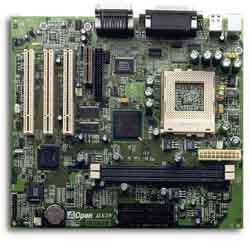What happens when you combine Intel's latest motherboard chipset with the second largest motherboard manufacturer in the world? You get the new AOpen MX3W, the first 810 based motherboard AnandTech has looked at that truly fits the mold of what a low cost 810 board should be. Combining AOpen's history of stable motherboards, and the 810 chipset should yield some interesting results, the final question pretty much boils down to "how much?"
Most 810 boards that have hit the market seemed to be geared towards the wrong audience, often times the motherboard sell at prices greater than single processor BX motherboards. With the MX3W, AOpen may be able to break the tradition and actually sell a low-cost 810 board, which was what the chipset was originally designed for use with, low-cost motherboards.
New Anand Tech Report Card Rating 89/B+
| CPU Interface | Socket-370 |
| Chipset | Intel 810-DC100 |
| On-Board Video | 810-DC100 GMCH |
| I/O Controller | 801 ICH |
| L2 Cache | N/A (on-chip) |
| Form Factor | MicroATX |
| Bus Speeds | 66 / 72
/100 / 107 / 112 / 117 121 / 125 / 127 / 130 133 / 136 / 140 / 145 / 155 |
| Clock Multipliers | 3.0x - 8.0x |
| Voltages Supported | 2.0v/2.8v (Auto-Detect) |
| Memory Slots | 2 168pin DIMM Slots |
| Expansion Slots | 0 AGP Slot 1 AMR Slot 3 PCI Slots (3 Full Length) 0 ISA Slots |
| BIOS | Award BIOS |
The Good
| The Socket-370 MX3W features a 3/1/0 expansion slot configuration. The nomenclature AnandTech will be using for the expansion slot configuration of all 810 and future 820 motherboards is as follows: PCI/AMR/AGP. Meaning that the MX3W features 3 PCI, 1 AMR (Audio Modem Riser) and no AGP slots like most other MicroATX 810 boards. The PCI/AMR slots are driven by the on-board Intel 801AA ICH (I/O Controller Hub) which will be one of the more popular hub selections for motherboard manufacturers. | |
| The MX3W makes use of
the 810-DC100 GMCH (Graphics
and Memory Controller Hub) with a 4MB 100MHz display cache on the board itself.
The two 2MB 7ns SDRAM chips are manufactured by Hyundai and are automatically set at a 1:1
ratio with the FSB frequency of the motherboard. The MX3W does allow for two
settings, a 1:1 ratio or a 3:2 ratio, however in AnandTech's tests there was virtually no
noticeable increase/decrease in performance using either of the settings. This is
mainly because the display cache is used for z-buffering and the performance difference
between a 100MHz DC and one that is clocked at a higher frequency such as 133MHz or 150MHz
is negligible. All three of the PCI slots are capable of accepting full length PCI cards if that is a particular concern, however for most users interested in this type of a motherboard, it won't be. |
|
As with all 810 boards, the M3XW only features two 168-pin 100MHz SDRAM DIMM slots. The amount of memory rows a motherboard is capable of addressing is defined by the chipset, in this case, the 810 chipset. The 4 rows (two double sided banks) supported by the chipset is reflected by the two DIMM slots on the M3XW; the chipset also defines the memory bus frequency to be locked at 100MHz, regardless of the FSB frequency, so the only requirement is that you have PC100 compliant memory, there is no need to seek out the most reliable SDRAM at 133MHz+ since it'll only be running at 100MHz on this board (as well as any 810 board, once again, independently of the FSB speed).











0 Comments
View All Comments